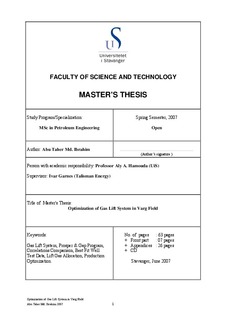| dc.contributor.author | Ibrahim, Abu Taher Md. | |
| dc.date.accessioned | 2008-07-16T11:14:28Z | |
| dc.date.issued | 2007 | |
| dc.identifier.uri | http://hdl.handle.net/11250/183233 | |
| dc.description | Master's thesis in Petroleum engineering | |
| dc.description.abstract | The objective of this thesis work is to obtain the optimum gas injection rate which yields the maximum oil production. Obtaining the optimum gas injection rate is important because excessive gas injection rate reduces oil production rate and increases operation cost.
To obtain the optimum gas injection rate for achieving the maximum oil production, all wells had been modelled by Prosper program and network solver calculation had been performed by Gap program. Flash data of recombined reservoir fluid had been used for PVT matching.
All available well test data including current well test data had been considered for quality checking. Since the reservoir parameter is continuously changing from inception of production, current well test data was the focus for using in the well model. It was found that current well test data for all wells had been matched nicely with calculated data in Prosper. Deviation range was below 3%.
For correlation comparison of VLP, Petroleum Expert 2 was found very close to well test data for all well models. Parameter 1 and 2 was close to unity. While matching surface flow line in Gap program, Duckler Flanning was found the best fit correlation for production and test flow line. Calculated manifold pressure was compared with the measured well head pressure and found very close results.
Currently oil is producing from eight wells of Varg field on which seven wells are producing with gas lift system. Presently average oil production rate of Varg field is around 2500 Sm3/day with gas lift injection rate around 600x103 Sm3/day. From simulation result of GAP program, maximum oil production rate was achieved 2867.0 Sm3/day at gas lift injection rate of 661.4x103 Sm3/day. At 500x103 Sm3/day gas lift injection rate, Gap calculates 2686 Sm3/day oil production rate. It has been observed from the simulation result that well A-05A is producing without gas lift injection due to low water cut. Production optimization and lift gas allocation rates achieved by this thesis work shows quite close results with current status of all producing wells.
In Varg field, all produced oil is processed by both production and test separators. For finding out the best combination for obtaining the maximum oil production, producing wells had been passed through different combinations of wells and separators. From this work, maximum oil production had been achieved by flowing well A-05A and well A-07 through the test separator and remaining six wells through the production separator. | |
| dc.format.extent | 3848285 bytes | |
| dc.format.mimetype | application/pdf | |
| dc.language.iso | eng | |
| dc.publisher | University of Stavanger, Norway | |
| dc.relation.ispartofseries | Masteroppgave/UIS-TN-IPT/2007 | |
| dc.subject | gas lift system | |
| dc.subject | prosper & gap program | |
| dc.subject | correlations comparison | |
| dc.subject | best fit well test data | |
| dc.subject | lift gas allocation | |
| dc.subject | production optimization | |
| dc.subject | petroleumsteknologi | |
| dc.title | Optimization of gas lift system in Varg field | |
| dc.type | Master thesis | |
| dc.subject.nsi | VDP::Technology: 500::Rock and petroleum disciplines: 510::Petroleum engineering: 512 | |
